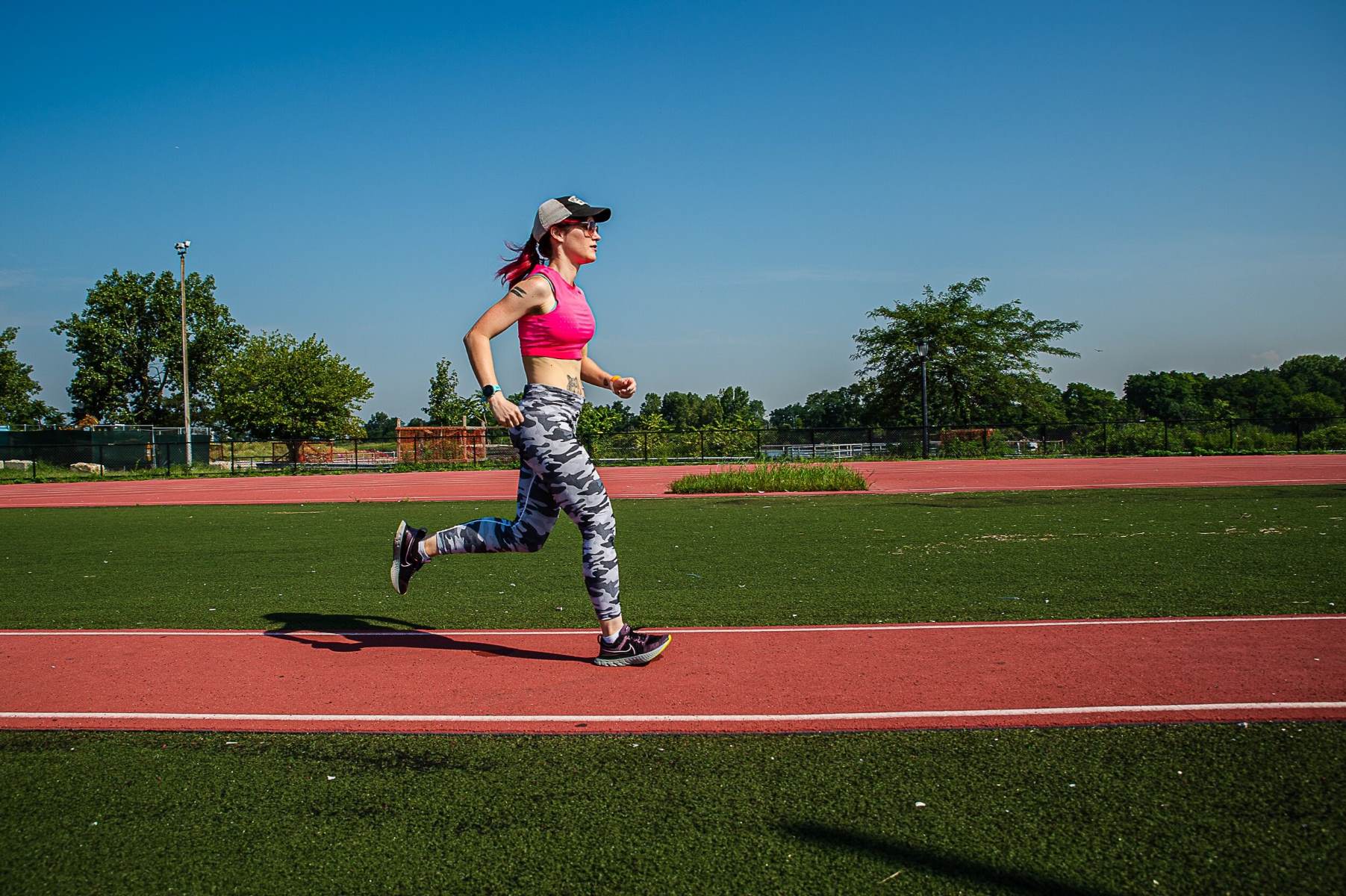

Featured
How Fast Is Jogging Speed
Modified: January 22, 2024
Discover the featured article on jogging speed. Learn how fast you should be jogging for optimal fitness benefits. Improve your pace and endurance now.
Introduction
Welcome to the world of jogging! Whether you’re a seasoned runner or just starting out on your fitness journey, understanding the ins and outs of jogging speed can help you set goals, track progress, and maximize your workout. When it comes to jogging, speed is a key factor that influences the intensity of your workout, calorie burn, and overall cardiovascular fitness.
But what exactly is jogging speed? How fast should you be running? And what factors affect your jogging speed? In this article, we will delve into the world of jogging speed and provide you with insights and tips to help you optimize your running performance.
Before we dive into the details, it’s important to note that jogging speed is a relative term and varies from person to person. It’s not about comparing yourself to others, but rather finding a pace that challenges you and allows you to maintain a steady rhythm throughout your run.
Factors such as age, fitness level, body composition, and running experience all contribute to your jogging speed. Understanding these factors and how they affect your performance can help you set realistic goals and make the necessary adjustments to improve.
So, whether you’re preparing for a race, looking to increase your overall fitness, or just want to enjoy the great outdoors, let’s explore the world of jogging speed and discover how you can enhance your running experience. Get ready to dash through this informative and engaging journey!
Key points:
- Jogging speed is an important factor to consider in your running routine.
- Speed varies from person to person and is influenced by factors such as age, fitness level, and experience.
- Understanding the concept of jogging speed can help you set goals and improve your overall performance.
Factors Affecting Jogging Speed
When it comes to jogging, there are several factors that can impact your speed and performance. By understanding these factors, you can make necessary adjustments to improve your jogging speed and overall running experience. Let’s take a closer look at some of the key factors that influence jogging speed:
- Physical Fitness: Your level of physical fitness plays a significant role in determining your jogging speed. Endurance, strength, and cardiovascular fitness are all important factors. Regular cardiovascular exercise, such as jogging or running, can enhance your overall fitness level and improve your ability to sustain a faster pace.
- Age: Age can also affect jogging speed. As we age, our muscle mass and overall fitness may decline, resulting in a decrease in speed. However, with the right training and maintenance of an active lifestyle, it is possible to maintain or even improve jogging speed as we get older.
- Body Composition: Body weight and muscle mass can influence your jogging speed. A lighter body weight can make running feel easier and allow for quicker strides. Additionally, having a higher ratio of lean muscle mass can improve your power and efficiency while running.
- Running Form: Your running form plays a crucial role in your jogging speed. Proper running form involves maintaining an upright posture, landing mid-foot, and having a quick turnover of your feet. Good form helps reduce energy wastage and allows for smoother and more efficient movement, resulting in faster speeds.
- Training and Experience: Consistent training and experience can significantly impact your jogging speed. Gradually increasing your mileage, incorporating interval training, and participating in races can help build endurance and increase your overall speed.
- Environmental Factors: External factors such as weather conditions, altitude, and terrain can affect your jogging speed. Running in hot and humid weather or at high altitudes may decrease your speed due to increased effort required for maintaining a steady pace. Similarly, running uphill or on rugged terrains can also slow you down.
It’s important to remember that these factors interact with each other and can have varying degrees of influence on your jogging speed. Don’t get discouraged if you don’t see immediate improvements. With consistency, patience, and dedication, you can overcome these factors and gradually enhance your jogging speed.
Key points:
- Physical fitness, age, body composition, running form, training, and environmental factors all contribute to jogging speed.
- Improving jogging speed requires consistent training, maintaining good running form, and considering external factors.
- Understanding these factors allows you to make necessary adjustments and improve your overall running performance.
Understanding Average Jogging Speed
When it comes to jogging, determining what constitutes an “average” jogging speed can be a bit subjective. Speed can vary greatly depending on factors such as fitness level, age, and running experience. However, having a general idea of average jogging speeds can help you gauge your performance and set realistic goals. Let’s explore some benchmarks for average jogging speed:
Pace per Mile:
One common way to measure jogging speed is by assessing the pace per mile. The average jogging speed for a beginner or someone just starting out might range from 12 to 15 minutes per mile. As your fitness improves and you gain more experience, the average jogging speed can increase to around 9 to 12 minutes per mile.
Keep in mind that these figures are just estimates and can vary based on individual factors. Some runners may be naturally faster or slower than these averages, and that’s perfectly okay. It’s important to focus on your own progress and not compare yourself to others.
Speed vs. Distance:
Another way to gauge jogging speed is by considering the distance covered within a specific time frame. For example, completing a 5K (3.1 miles) in 30 minutes would equate to an average speed of about 10 minutes per mile. If you’re able to maintain this pace consistently, it’s a good indication that you’re jogging at a steady and respectable speed.
Training and Improvement:
It’s worth noting that jogging speed is not fixed and can be improved with training and practice. By incorporating interval training, tempo runs, and speed work into your routine, you can gradually increase your overall speed and endurance. Consistency is key when it comes to improving jogging speed, so finding a training plan that suits your goals and abilities is crucial.
Remember, the goal is not to push yourself to the limits and sprint at all times. Jogging is meant to be a sustainable and enjoyable activity, so finding a pace that you feel comfortable with is essential. Listening to your body and gradually challenging yourself can lead to steady improvement in your jogging speed over time.
Key points:
- Average jogging speed can vary based on factors such as fitness level, age, and experience.
- Beginners might have a jogging speed of 12 to 15 minutes per mile, while more experienced runners can range from 9 to 12 minutes per mile.
- Distance covered within a specific time frame can also indicate average jogging speed.
- Consistent training and gradual improvement are key to increasing jogging speed.
Tips for Increasing Jogging Speed
If you’re looking to boost your jogging speed and take your running to the next level, here are some helpful tips and strategies to consider:
- Incorporate Interval Training: Interval training involves alternating between high-intensity bursts of speed and periods of recovery. By challenging your body with short bursts of faster running, you can improve your running economy and increase your overall speed. Start by incorporating short intervals, such as 30 seconds of sprinting followed by 1 minute of recovery, and gradually increase the duration and intensity as your fitness improves.
- Focus on Strength Training: A strong body can contribute to faster jogging speeds. Incorporating strength training exercises, such as squats, lunges, and planks, into your workout routine can improve your overall muscular strength and power. Stronger leg muscles, in particular, can help propel you forward with each stride.
- Work on Running Form and Technique: Proper running form can make a significant difference in your jogging speed. Focus on maintaining an upright posture, engaging your core, and landing mid-foot with each step. Avoid overstriding and try to increase your cadence (the number of steps you take per minute). A shorter, quicker stride can help improve your running efficiency and speed.
- Include Speed Workouts: In addition to interval training, incorporating dedicated speed workouts into your routine can enhance your jogging speed. These workouts can include tempo runs (running at a comfortably hard pace for an extended period), fartlek runs (alternating between faster and slower speeds during a run), or hill repeats (sprinting uphill and recovering on the downhill). These workouts challenge your body to adapt to faster speeds and improve your overall performance.
- Cross-Train for Conditioning: Engaging in other cardiovascular activities, such as cycling, swimming, or using an elliptical machine, can improve your cardiovascular conditioning and support faster jogging speeds. Cross-training helps build endurance and strengthens different muscle groups, contributing to overall running performance.
- Gradually Increase Mileage: Increasing your weekly mileage gradually and consistently can improve your jogging speed by enhancing your endurance. Aim to increase your total running distance by no more than 10% each week to minimize the risk of injury and allow your body to adapt to the increased demands.
- Take Rest and Recovery Seriously: Rest and recovery days are crucial for the growth and repair of your muscles. Avoid overtraining by allowing adequate rest days between intense workouts. This allows your body to recover, reducing the risk of injury and allowing for better performance during your runs.
Remember, improving your jogging speed takes time and patience. Be consistent, stay motivated, and listen to your body to avoid pushing yourself too hard. With dedication and these helpful tips, you’ll be on your way to faster and more enjoyable runs.
Key points:
- Incorporate interval training, strength training, and speed workouts to improve jogging speed.
- Focus on proper running form and technique to enhance running efficiency.
- Cross-train for conditioning and gradually increase mileage for improved endurance.
- Rest and recovery are essential for preventing injury and optimizing performance.
Common Mistakes to Avoid While Jogging
Jogging is a fantastic form of exercise that offers numerous health benefits. However, certain mistakes can hinder your progress or even lead to injury. By being aware of these common mistakes, you can make the necessary adjustments to ensure a safe and effective jogging routine. Here are some mistakes to avoid while jogging:
- Overstriding: Overstriding refers to taking excessively long strides while running. This can lead to inefficient movement, increased impact on joints, and a slower pace. Instead, focus on maintaining a shorter stride that allows for a faster cadence and more efficient running form.
- Ignoring Warm-up and Cool-down: Many runners neglect to warm up properly before a jog and skip the cool-down afterward. Skipping these crucial steps increases the risk of muscle strains, cramps, and other injuries. Prioritize a dynamic warm-up that includes movements that mimic running, such as leg swings and lunges. After your jog, cool down with light jogging or walking and stretch major muscle groups.
- Pushing Too Hard, Too Soon: It’s tempting to push yourself to achieve fast results, but it’s important to progress gradually. Increasing mileage, intensity, or speed too quickly can lead to injuries such as shin splints, stress fractures, or tendonitis. Follow the principle of gradual progression, and listen to your body’s signals to avoid overexertion.
- Neglecting Rest Days: Rest days are essential. They allow your body to recover and adapt to the stress of jogging. Without adequate rest, you increase the risk of injury and hinder your performance. Incorporate one or two rest days per week, allowing your muscles and joints to rest and rebuild.
- Poor Running Form: Having incorrect running form can diminish your jogging speed and increase the risk of injury. Avoid common form mistakes such as slouching, excessive arm swinging, or running with a stiff upper body. Focus on maintaining an upright posture, relaxed shoulders, and a slight forward lean from the ankles. Keep your arms bent at around 90 degrees and swing them naturally, mirroring your leg movement.
- Solely Focusing on Speed: While it’s important to challenge yourself and work on speed, solely focusing on speed can neglect other vital aspects such as endurance, strength, and flexibility. Incorporate a mix of different workouts, including long, slow jogs for endurance, tempo runs for speed, and strength training for overall fitness.
- Not Listening to Your Body: It’s essential to listen to your body and pay attention to any pain or discomfort during or after jogging. Ignoring warning signs can lead to more severe injuries. If you feel sharp pain, persistent discomfort, or experience unusual symptoms, consult a healthcare professional to ensure proper diagnosis and treatment.
By avoiding these common mistakes and practicing proper technique and self-care, you can optimize your jogging routine and reap the full benefits of this fantastic exercise.
Key points:
- Avoid overstriding, neglecting warm-up and cool-down, and pushing too hard, too soon.
- Take rest days, prioritize good running form, and maintain a balanced workout routine.
- Listen to your body and seek medical attention if experiencing pain or discomfort.
Health Benefits of Jogging
Jogging offers a wide range of health benefits that go beyond just improving cardiovascular fitness. Regular jogging can have a positive impact on various aspects of your physical and mental well-being. Let’s explore some of the key health benefits that jogging provides:
- Improved Cardiovascular Health: Jogging is a fantastic aerobic exercise that strengthens your heart and lungs. It increases your heart rate, improves blood circulation, and enhances oxygen delivery to your muscles. Regular jogging can lower the risk of cardiovascular diseases, such as heart disease, high blood pressure, and stroke.
- Weight Management: Jogging is an effective form of exercise for weight loss and weight management. It burns calories and helps create a calorie deficit, which is essential for shedding excess pounds. By incorporating jogging into your routine, you can improve your body composition, increase muscle tone, and maintain a healthy weight.
- Increased Bone Density: Jogging is a weight-bearing exercise that stimulates bone growth and strengthens your skeletal system. Regular jogging helps prevent age-related bone loss and reduces the risk of osteoporosis, a condition characterized by weak and brittle bones.
- Improved Mental Health: Jogging has a positive impact on mental health. It releases endorphins, the “feel-good” hormones that boost mood and reduce stress and anxiety. Regular jogging can help alleviate symptoms of depression, improve sleep quality, and enhance overall psychological well-being.
- Enhanced Respiratory Health: Jogging increases lung capacity and improves respiratory function. It strengthens the respiratory muscles, increases the exchange of oxygen and carbon dioxide, and improves lung efficiency. This can lead to improved athletic performance and a reduced risk of respiratory conditions such as asthma.
- Boosted Immune System: Regular jogging has been shown to enhance immune function and decrease the risk of illness. It strengthens the immune system by increasing the circulation of immune cells, promoting better response to pathogens, and reducing inflammation in the body.
- Increased Energy Levels: Engaging in regular jogging can boost energy levels and combat fatigue. It improves stamina, increases oxygen delivery to the muscles, and promotes the release of energy-boosting neurotransmitters, leading to increased vitality and overall improved productivity.
- Longevity and Aging: Jogging has been linked to increased longevity and a reduced risk of premature death. Regular joggers tend to have improved overall health and a decreased risk of chronic diseases associated with aging, helping them maintain an active and independent lifestyle as they get older.
Incorporating jogging into your routine can provide a multitude of health benefits for both your body and mind. It’s a simple and accessible form of exercise that can be enjoyed by people of various fitness levels, making it a fantastic choice for anyone looking to improve their well-being.
Key points:
- Jogging improves cardiovascular health, aids in weight management, and increases bone density.
- It boosts mental health, enhances respiratory function, and strengthens the immune system.
- Regular jogging increases energy levels, promotes longevity, and slows down the aging process.
Injury Prevention and Jogging Speed
While jogging offers numerous health benefits, it’s essential to prioritize injury prevention, especially when it comes to increasing your jogging speed. As you push your limits and aim for faster speeds, it’s crucial to take precautions to minimize the risk of injury. Here are some key considerations for injury prevention when it comes to jogging speed:
- Gradual Progression: One of the most important factors in preventing injuries is gradual progression. Avoid sudden increases in speed or mileage, as it can put undue stress on your muscles and joints. Instead, gradually increase your jogging speed over time, allowing your body to adapt to the new demands. This slow and steady approach helps reduce the risk of overuse injuries.
- Proper Warm-up and Cool-down: Before starting your jog, it’s essential to warm up properly. A dynamic warm-up routine should include activities that activate your muscles and prepare your body for the upcoming workout. Cooling down afterward with light jogging or walking and stretching helps reduce muscle soreness and promotes recovery.
- Strength and Conditioning: Incorporating strength and conditioning exercises into your routine can help prevent injuries while increasing jogging speed. Strengthening muscles, particularly those in your lower body, can provide better support and stability. Focus on exercises that target the core, hips, glutes, and legs to improve overall strength and reduce the risk of imbalances or weaknesses that can lead to injury.
- Proper Footwear: Wearing appropriate footwear is crucial for injury prevention. Invest in a pair of running shoes that provide adequate support and cushioning for your feet and ensure a proper fit. Replace your shoes regularly as they wear out to maintain optimal support and shock absorption.
- Listen to Your Body: Pay attention to any signs of pain, discomfort, or unusual sensations during or after running. Pushing through pain can lead to further injury. It’s important to distinguish between normal muscle soreness and potential signs of injury. If you experience persistent pain or have concerns, consult a healthcare professional.
- Cross-training: Incorporating cross-training activities into your routine can help prevent overuse injuries. Engage in low-impact exercises such as swimming, cycling, or strength training to give your body a break from the repetitive stress of running while still maintaining fitness.
- Rest and Recovery: Rest days are crucial to allow your body to recover and rebuild. Overtraining can lead to fatigue, weakened immune function, and an increased risk of injury. Schedule regular rest days in your training program to give your body the time it needs to repair and adapt to the demands of jogging.
By prioritizing injury prevention and taking the necessary precautions, you can enjoy the benefits of jogging speed while minimizing the risk of setbacks and injuries. Remember, it’s better to progress slowly and stay injury-free than to push too hard and suffer the consequences. Listen to your body, be mindful of your form, and maintain an overall balanced approach to your jogging routine.
Key points:
- Gradual progression, proper warm-up and cool-down, and strength training help prevent injuries while increasing jogging speed.
- Choose appropriate footwear and listen to your body to avoid overexertion and pain.
- Incorporating cross-training activities and allowing for rest and recovery are essential for injury prevention.
Conclusion
Congratulations! You’ve reached the end of our comprehensive guide to jogging speed. We’ve explored various aspects of jogging speed, including the factors that affect it, tips to increase it, common mistakes to avoid, the health benefits of jogging, and strategies for injury prevention. Whether you’re a beginner or an experienced jogger, understanding these concepts can help you optimize your running performance and make the most out of your jogging routine.
Jogging speed is a personal journey that is influenced by a combination of factors, including physical fitness, age, running form, and training experience. It’s essential to set realistic goals and gradually improve your speed over time. Remember, it’s not about comparing yourself to others, but about challenging and improving yourself.
By incorporating interval training, strength training, and speed workouts, you can increase your jogging speed. Additionally, focusing on proper running form, listening to your body, and allowing for rest and recovery will help prevent injuries and promote long-term fitness.
Jogging offers a multitude of health benefits, including improved cardiovascular health, weight management, increased bone density, enhanced mental well-being, and boosted immune function. It’s an accessible and enjoyable form of exercise that can be adapted to suit different fitness levels and goals.
As you embark on your journey to improve your jogging speed, remember to be patient and stay consistent. Celebrate small milestones and enjoy the process of challenging yourself and improving your overall fitness and well-being.
Above all, make sure to listen to your body and prioritize your safety and health. If you experience persistent pain or have any concerns, consult a healthcare professional for guidance.
Now lace up your shoes, hit the pavement, and embrace the joy of jogging as you strive to reach new speeds and achieve your fitness goals. Happy running!









